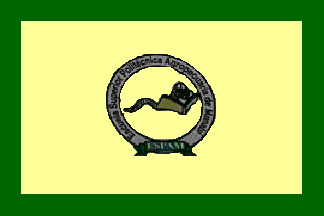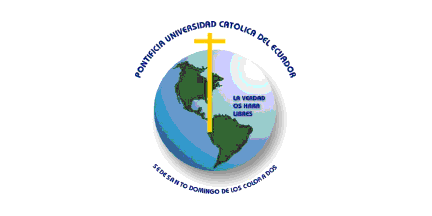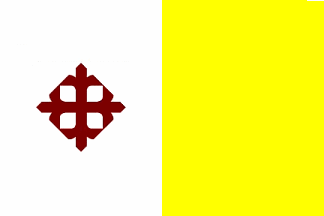
image by Dov Gutterman, 6 August 2002

Last modified: 2009-08-15 by dov gutterman
Keywords: ecuador |
Links: FOTW homepage |
search |
disclaimer and copyright |
write us |
mirrors
See also:
See also:

image by Dov Gutterman, 6 August 2002
Based on <www.comil.edu.ec>.
Dov Gutterman, 6 August 2002
On 7 July 1838, President of the Republic Vicente Rocafuerte
(1783-1847, President in 1834-1839) founded in Quito a miltary
college. Close and reopened in the next decades by different
presidents, the college was eventually reestablished on 11
December 1899 by General Eloy Alfaro (1842-1912, President in
1897-1901 and 1906-1911), considered as the modernizer of the
Ecuadorian army. In 1937, President Federico Páez (1876-1974,
President in 1935-1937) added "Eloy Alfaro" to the name
of the college.
The flag of the institute, according to a photo
available on the website of the institute showing it flying
together with a red triangular flag, is diagonally divided
yellow-black by the ascending diagonal, with the emblem of the
institute in the middle.
Yellow represents the constance, brightness and resource of the
spirit of the cadets.
Black represents sobriety, definition and modesty in their acts.
The emblem
of the institute [3] is made of a light blue shield, representing
the limpid, still and optimist sky, with a yellow map of Ecuador
inscribed with the name of the country in black capital letters
and charged with a hand holding the torch of science, truth and
culture. A yellow scroll bears the motto of the institute in
black letters, "SOLO VENCIENDOTE VENCERAS". The shield
has a yellow border bearing the name of the institute in black
letters. The shield is surmonted by a helmet argent with a red
grid and three feathers in the national colours, yellow, blue and
red.
Ivan Sache, 8 February 2009

image image by Dov Gutterman, 6 August 2002
Based on <www.municipalidadcuenca.gov.ec>.
Dov Gutterman, 6 August 2002

image by Eugene Ipavec, 4 May 2007
The Escuela Politécnica del Ejército (Polytechnic School of
the Army) is located in Quito and was originally established for
the education of Engineer Officers in the Ecuadorian Army. It
then evolved into the Ecuadorian Military Academy but since 1977
it has transformed itself into a standard civilian
university with a full range of civil as well as military career
opportunities. The university logo can be seen at <www.espe.edu.ec>;
it seems strange that an institution with such military
antecedents does not posess a flag or standard. However, I found
something on a Spanish web site, <www.dara.es>, which
may well be the university flag even though the site refers to it
as a shield. On the university's own home page the logo is simply
placed on a white background, but on this Spanish site it is
centered on an oyster colored rectangular background. It looks
like a flag, the institution ought to have a flag, but they have
not responded to my queries and therefore all that I can do is to
refer to this image as a possible flag.
Ron Lahav, 4 May 2007
It does have a flag: <www.espe.edu.ec>,
the little one on the podium (better visible in some of the other
photos). Red/green diagonal with emblem in center.
Eugene Ipavec, 4 May 2007

image by Ivan Sache, 2 June 2004
The flag of the Polytechnical Agricultural Superior College is
beige with a dark green border and the emblem of the College in
the middle. The flagstaff shall be of coffee colour. Green stands
for the agricultural wealth of the city of Calceta and the canton
of Bolivar, as well as for hope. Beige stands for hospitality,
work and solidarity expressed by the inhabitants of the region.
The emblem of the College shows an earthworm, which is born in
earth, feed from earth, converts earth into humus and eventually
feeds earth. The earthworm wears an orange sombrero and reads a
book. It is inscribed in a double circle in which is written the
name of the college. The acronym ESPAM is written on a green
ribbon placed below the circles.
Note that the space between the two circles should probably be
beige, too. Unfortunately, I have not been able to find a better
image of the reading earthworm emblem.
Source: Escuela
Superior Politécnica Agropecuaria de Manabí
Ivan Sache, 2 June 2004

image by Eugene Ipavec, 11 April 2005
.gif)
coat of arms
image by Eugene Ipavec, 11 April 2005
ESPOCH - Escuela Superior Politecnica de Chimborazo
(Chimborazo Higher Technical College) is located in Riobamba. The college flag (tricolor of
red-white-green) can be seen at <www.espoch.edu.ec>.
Ron Lahav and Eugene Ipavec, 11 April 2005

image by Eugene Ipavec, 4 May 2007
The Escuela Superior Politécnica del Litoral (Higher
Polytechnic College of the Littoral) is located in Guayaquil. The
university flag can be seen at <www.espol.edu.ec>.
Ron Lahav, 4 May 2007
ESPOL was founded by Executive Decree No. 1664, published in
the Ecuadorian official gazette on 11 November 1958. Classes
officially started on 25 May 1959. In March 2002, the institute
catered more than 12,000 students taught by more than 800
professors and 500 other employees.
Article 5 of the new statutes of ESPOL, adopted in 1998, says:
"Escuela Superior Politécnica del Litoral shall use the
patriotic symbols of Guayaquil and its own symbols as well. Its
motto is "Ciencia, Tecnología y Educación al servicio del
país" [Science, Technology and Education to the service of
the country] and its acronym is ESPOL."
Flag - The Polytechnical Council approved on 14 December 1993 the
report presented by Robert Toledo Echeverría, Vice Rector in
charge of Students' Affairs and Welfare, and prescribed the flag
of ESPOL to be: A rectangular field with three light blue
("celestes") and two white stripes.
The upper and lower light blue stripes shall be twice higher than
the light blue central stripe.
The white stripes shall be slightly ("ligeramente")
higher than the light blue stripe they flank. In the middle of
the flag shall be placed an allegory made of a circle charged
with a "galápago", below it the words "Guyaquil -
Ecuador". [The "galápago" is the Galápagos
(giant) tortoise, Geochelone nigra Quoy & Gaimard, a
species endemic to the Galápagos islands, with ten subspecies
still alive (out of the 12 recorded). More details at wikipedia].
Above the circle shall be placed the acronym ESPOL, below the
circle shall be placed "Octuber de 1958" [October
1958], the foundation date of the institute.
Below the circle shall be written the name of the institute
"Escuela Superior Politécnica del Litoral".
The circle shall be surrounded by olive branches, symbols of
knowledge, peace and excellence.
Below the lower writing shall be placed a white star symbolizing
the Guayaquil Star [this seems to
have been changed for a light blue star placed in the upper part
of the circle].
The flag of the institute shall be used in all the official acts
of ESPOL.
Emblem - The emblem / seal of ESPOL was created in 1958 by the
founder and first Director of the institute, Walter Camacho
Navarro. The seal was oval, charged with a laurel crown
surrounding the Guayaquil Star.
Outside the oval were written "Escuela Superior Politécnica
del Litoral" and "1958". Used for the first 15
years of existence of the institute, until Rector Luis Parodi
Valverde decided that the emblem of the instituteshould be more
closely related to Ecuador. In 1974, without any official
decision, a donkey's head was added to the emblem, which was
nothing but original, since this is the symbol used by the
National Polytechnical Institute of México.
Accordingly, the Board of ESPOL launched a competition for
designing the emblem of the instutute. On 25 November 1974, the
Board approved the proposal made by Carlos Quevedo Flores, which
includes a "galápago", the world famous symbol of the
Galápagos islands, and, therefore, of Ecuador.
Source: <www.espol.edu.ec>.
Ivan Sache, 12 April 2009

image by Ivan Sache, 2 June 2004
PUCESD is Pontificia Universidad Catolica del Ecuador - Seat
of Santo Domingo de los Colorados, that is the Faculty of the
Pontifical Catholic University of Ecuador in Santo Domingo de los
Colorados. The PUCESD was created upon request by Mgr Emilio
Lorenzo Stehle, who already created in 1991 an Instituto Superior
de Pedagogia. The PUCESD was inaugurated on 6 April 1998.
The flag of the PUCESD is white with the emblem of the University
placed in the middle. The picture shown on the PUCESD website
seems to be a close-up of the emblem, therefore I have drawn the
flag with 1:2 proportion, like the national flag of Ecuador.
White stands for purity, whereas the emblem shows the union with
the principal seat of the university in Quito. It is similar ot
the emblem of the Quito seat except the motto.
The emblem of the PUCESD incudes five elements:
- a yellow cross
- a green map of south America
- the PUCESD motto in light blue
- the earth
- the name of the University and seat in blue, around the emblem.
Santo Domingo de los Colorados is the
capital city of a canton located in the province of Pichincha.
The motto of the PUCESD is: La verdad os hara libres.
Source: PUCESD
website.
Ivan Sache, 2 June 2004
"Unidad Educativa 'Corazón de María'", located at
Cuenca, is run by the nuns of the Congregation of the Oblate
Nuns.
The congregation was founded in Cuenca by Father Julio María
Matovelle. Mother Leticia de Jesús Célleri, Superior General of
the congregation, commissioned Noemí Gárate Espinoza to found
an educative institute, which was recognized by Ministerial
Decree No. 1099 on 30 September 1959. The institute was named
after the patron of the congregation, the Heart of Mary.
The flag of the institute, according to the photo and the description
available on the website
of the institute, is horizontally divided light blue-white
with the emblem of the institute in the middle. The colours of
the flag are the traditional Marian colours.
On the flag, the emblem of the institute is a blue shield with a
white open book (as the symbol of the future opened by science)
charged with a white lily (on the left page, as the symbol of the
good souls) and a dove (on the right page, as the messager of
peace), supported by a red cross. The shield is surrounded by a
blue border, charged on top with the white writing "UND ED
CORAZON DE MARIA". A white scroll on the base of the shield
bears the Latin congregation's motto in red letters "OB
AMOREM DEI" (For the love of God). There is a golden fringe
around the flag.
The emblem of the institute, as shown graphically on the wesbite
of the institute, seems to be a modernized version of theemblem
shownon the flag.
Ivan Sache, 8 February 2009
"Unidad Educadiva San Felipe Neri" (UESFN) was
founded at Riobamba by the Society of Jesus. On 13 October 1836,
President of the Republic Vicente Rocafuerte appointed Dr. J.
Véloz "Rector del Colegio Nacional de San Felipe
Neri"; however, the effective foundation date of the
institute is considered to be 25 April 1838. "Colegio San
Felipe Neri" was transformed into "Unidad Educadiva San
Felipe Neri" by the Ministry of Education on 21 September
2000 (Decree No. 931). The institute is named after St. Philip
Neri (1515-1595, canonized in 1622), an Italian priest and
mystic, founder of the Congregation of the Oratory in 1575.
A photo
taken during the "Proclamación de Abanderados y Escoltas
2008-2009" ceremony shows the flag of the institute as
horizontally divided blue-white-blue (1:2:1) with the emblem of
the institute in the middle, slightly overlapping on the blue
stripes. The flag is bordered with a fringe argent.
The emblem
of the institute was adopted on 21 September 2000, when the
institute was granted its current status and name. The emblem is
made of a shield vertically divided, the left half being yellow
with seven red bends and the right half being silver with a
cauldron flanked by two wolves, all in black. The shield is
surmonted by the foundation year, "1836", in blue, and
placed on a white disk surrounded by a grey ring charged with
"UNIDAD EDUCATIVA SAN FELIPE NERI" (top) and
"RIOBAMBA - ECUADOR" (bottom), in blue letters. The
shield is presented on the website of the institute as inspired
by the arms of Ignatius of Loyola, the founder of the Society of
Jesus. On the flag, there is a clear difference between the white
and silver elements, but the colour of the writing does not seem
to be blue, but rather or.
A similar coat of arms is used by the Society of Ex-Alumni of the
Colleges of the Society of Jesus, presented on the website of
"Colegio
San Ignacio de Loyola" of Piura, Peru. Ignatius de
Loyola was born Iñigo de Oñaz y Loyola, and his arms were
"Per pale, Oñaz and Loyola". The dexter part of the
shield, "Gules seven bends gules", was the coat of arms
of the Oñaz family. The seven bends were conferred by King
Alfonso XI of Castile to the seven Oñaz brothers who faught
during the battle of Beotivar in 1321, repelling, together with a
few Basque fellows, Gascon and Navarrian troops.
The sinister part of the shield, "Argent a cauldron flanked
by two wolves rampants, all sable", was the coat of arms of
the Loyola family. The wolves, symbols of ardor to war, are
canting for the name used by the saint in his youth, Iñigo
López de Loyola ("lobo" means "a wolf" in
Spanish). The cauldron may recall the affluency of the Loyola
family.
Ivan Sache, 8 February 2009

image by Eugene Ipavec, 17 August 2007

pennant
image by Eugene Ipavec, 17 August 2007
The Catholic University of Santiago de Guayaquil is located in
Guayaquil. A description of the
university flag and logo, which is displayed on the flag, and
also a color photograph of the flag, can all be seen at <www.ucsg.edu.ec>.
The university flag is almost identical to the Papal
or Vatican flag, with the exception that the University Logo
is positioned where the Papal tiara and Crossed Keys are on the
Papal flag.
Ron Lahav, 17 August 2007
There's also a pennant, termed an "estandarte," on
the same page. Translated: "In the inaugural ceremony of the
main building, the archbishop monsignor Manuel de Jesús Serrano
Abad blessed the standard, that is a symbol of triangular form
with the cross of Santiago, patron of the city and school, which
expresses what the university hopes for its members: faith pure
and uncontaminated, fidelity to the traditions that it demands,
gratitude to conscience as opposed to circumstance of life. The
emblem presides over the official acts that are celebrated in the
university.
The flag, a bicolor with vertical bands of white and yellow, was
approved officially by the University Council on the 13 of June
of 1977. Since then it flies on campus every memorial day and
every Monday next to the flags of Ecuador and Guayaquil."
Eugene Ipavec, 17 August 2007

image from university web site
Universidad San Francisco de Quito (St. Francis University of
Quito) is a Roman Catholic institution located in the capital of
Ecuador. I have received an e-mail from the Sub-Assistente en la
Oficina del Rectorado, in reply to a request for information
concerning a possible university flag, which informs me that the
logo which appears on the university
web site, has actually recently 'evolved into a squarely
shaped banner type of flag at the suggestion of one of the
Profesores who said to the Rector that because this logotipo
looks like a flag why is it not made into a flag.
Ron Lahav, 11 April 2005